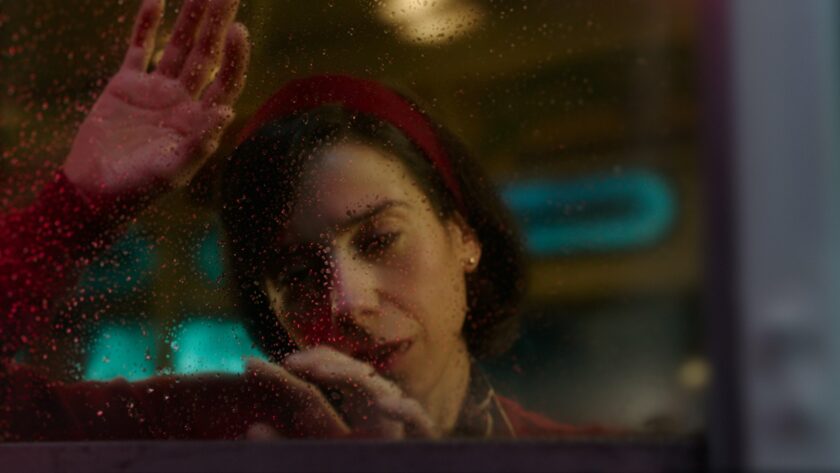Liam Donovan tackles Guillermo del Toro’s latest fantastical feature.
There are men who can be monstrous, and monsters who can demonstrate great humanity, a principle on which Guillermo Del Toro has built his career as a filmmaker. In Hellboy, the titular hero must overcome his infernal origins to save somebody he loves, while the director’s last offering, Crimson Peak, leads us to believe our protagonist is threatened by a ghostly presence, only to reveal true evil contained within a human form.
This theme has never been more prominent though than here, The Shape of Water proving itself to be an enchanting love letter to the ‘Other’, as expressed through yet another of those strange fantasies which Del Toro has displayed such a fascination with. Assimilating influences that range from fifties musicals to Cold War era spy-thrillers, this genre-mash has already been a massive success, garnering a staggering thirteen Oscar-nominations, and being held up alongside Pan’s Labyrinth as one of Del Toro’s masterpieces. The hype seems almost too great.

Set sometime in 1962, a period of increasingly heightened tensions that either stand apart from, or reflect, more contemporary issues, The Shape of Water is largely focused around the top-secret government facility where our main character, Elisa (Sally Hawkins), goes about her monotonous profession as a janitor, each night reduced to specific and unfulfilling routine. Much like her neighbour Giles (Richard Jenkins), an artist too frightened to express the true nature of his feelings and sexuality, Elisa finds her existence lonely and disconnected, despite her close friendship with fellow janitor Zelda (Octavia Spencer). Also, and this is important, she can’t speak. Elisa is completely mute, which offers her both an adorable vulnerability and an air of alluring mystery.
Her life is drastically changed when she comes into contact with a strange, amphibian creature (Doug Jones) that is brought into the laboratory, described as a possible god to the people of South America where it was discovered. With humanoid features, and an ability to communicate, this creature and Elisa form an intimate bond, until the life of the beast is threatened by the fierce and cruel Colonel Strickland (Michael Shannon), forcing Elisa to make a desperate decision.

Presented as an ‘adult fairytale’, the distinctly romantic tone of the film permeated by outbursts of graphic violence and even some nudity, The Shape of Water is built around a strange and scintillating relationship that shouldn’t work but unquestionably does. It makes the most sense when you view it as a kind of metaphor, whether that be for Del Toro and his own passion for the weird and wonderful, or maybe the idea that affection can exist beyond the realms of what is conventional, where people are seen for the content of their soul rather than external appearances. Perhaps this is a love story between two people who, shut off from the rest of the world, find their own way to communicate with one another.
If that all sounds too idealistic, and potentially sentimental, then it’s probably because it is. Nevertheless, Del Toro’s movie is so sincere and exquisitely crafted, the director designing his own magical landscape within our world, you can’t help but fall in love with it too, even if the thought of Sally Hawkins entering relations with a fish-man seems, at first, too off-putting to be genuinely sympathetic and touching.

It seemed unlikely that, in this year’s awards race for Production Design glory (okay, well at least I care), Dennis Gassner’s impeccable work in creating the expansive world of Blade Runner 2049 could be beaten. However, by bringing together Del Toro’s gorgeously assembled vision of sixties-era America, which feels striking and large in scope, but also incredibly intimate, Paul D. Austerberry must be a front-runner as well. Working under immense budgetary constraints, with The Shape of Water supposedly made for less than twenty million dollars, Austerberry drops us into an artful and immersively detailed environment that feels so physical and tangible that you almost want to reach through the screen and touch it.
The transporting sensation of the setting is only bolstered by the evocative cinematography of Dan Laustsen, who seems to find every shade of green to shoot this feature through, and the retrograde score of Alexandre Desplat, which chimes seamlessly with the timely soundtrack. That being said, a beautifully drawn metaphor, translated to screen, does not resonate nearly as well as The Shape of Water does, for which we have Guillermo Del Toro to thank.
In order to make us really care about the romantic core of the film, which in these circumstances is quite a feat, Del Toro has to conjure all the heart and soul he can muster, creating enchanting and even erotic sequences that spark an unsettlingly tantalising chemistry between Elisa and her fishy suitor. If one had to consider what the ‘shape’ of water really is here, then perhaps we could relate its undulating movements and gracefulness to that of a sexual body, Del Toro offering us the imagery of the egg as yet another suggestive symbol; through these images, the director subconsciously establishes an erotic language between the unlikely lovers.

The visual separation of the two as they initially meet, barriers placed between them that ultimately begin to crumble, creates a sense of longing, a irreconcilable desire that echoes the dissatisfaction of other characters in the film, including Jenkins’ Giles who, secretly attracted to the waiter of a local ‘pie parlour’ (disclaimer: not an accurate description), is also frightened to indulge his secret yearning. In terms of the sea-creature Elisa is enamoured by, one might see Dr. Hoffstetler (Michael Stuhlbarg) as a potential love rival, this scientist in the government laboratory also desperate to protect what he considers a beautiful specimen. The characters in The Shape of Water are, even in the case of Shannon’s villain Strickland, seeking connection.
Although the script, co-penned by Del Toro and Game of Thrones producer Vanessa Taylor, is structured so to gradually absorb us in the burgeoning romance of this fantastical tale, credit must be given to the performers who bring this material to complex life. Sally Hawkins doesn’t speak, but she exudes emotion and her own form of language through simple looks, gestures, or her slightly awkward but innocent movement. Born an orphan by the river, she still appears to be stuck in the dizzying bubble of her youth, where the secret behind her silence is concealed.
Doug Jones, who has long been Del Toro’s go-to guy for his humanely monstrous creations, gives equally innocent and elegant motion to Elisa’s amphibian counterpart, and together they make an extremely watchable pair. As the Oscar nominations for both Jenkins and Spencer would suggest, the supporting cast also play valuable roles, often grounding the more unbelievable content of this magic-realist story, and each experiencing their own trials and tribulations which, like Elisa, they must learn to overcome by the end of the film.

Possibly The Shape of Water’s only weak-spot is Shannon as Colonel Richard Strickland, though he is often gloriously vicious and – as his rotting fingers would suggest – an important counterpoint to the Doug Jones’s creature. Over the course of the film Strickland literally decays into a grotesque monster of a man. However, despite Shannon’s entertaining performance, this antagonist is probably a little too chin-stroking and blatantly sinister, Del Toro’s attempts to reveal his private life and semblance of humanity not translating as well as his work with the other characters, all of whom become hurdles for Strickland to violently neutralise.
That being said, there is something charming about an old-school villain who doesn’t quite fit into a grey area, and is instead just an outright bastard. Literally wielding an electric cattle-prod, like some sixties, suited version of Anton Chigurh, the paraphernalia of his malevolence may be slightly overblown, but few are better in this kind of scenery-chewing role than Michael Shannon.

In The Shape of Water, Guillermo Del Toro indulges the kind of perverted, yet weirdly poignant, romantic-fantasy one might expect from a B-Movie, but chooses to present it as a prestige piece of Old Hollywood, set around lavish movie theatres with an overflowing abundance of style. Inhabiting the limitless streams of the director’s imagination are carefully-sketched characters who are both playful and emotionally resonant, pulling us into the midst of wickedly weird events that are charming, thrilling and extremely powerful.
If Pan’s Labyrinth guided us through the unbounded expanse of a child’s dream, then The Shape of Water is potentially a more grown-up affair, a film where those dreams of an intense communion with the supernatural continue to perforate reality. Drenched in liquid, and flowing like the uncertain river where our protagonist is first discovered as a baby, Del Toro’s movie flows through its audience as well.
The Shape of Water is out now in UK cinemas. Check out the trailer below:




